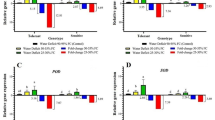Abstract
Forty-three lines of barley, including ancestral (wild), landraces, Middle Eastern lines, and modern cultivars, were grown under two different sets of environmental conditions. Hordenine production in barley roots was determined at the one-leaf stage by HPLC analysis and, in two lines only, over a period of 35 days. Forty-two of the 43 lines produced significant amounts of hordenine, although there was no variation among groups. Middle Eastern lines had the highest production with 327 µg/g on a dry weight basis. Production was, however, determined more by environmental conditions during growth than by genetic factors. Hordenine production was up to seven times higher in plants grown under lower light intensities.
Similar content being viewed by others
References
Gentry, C.E., Chapman, R.A., Henson, L., andBuckner, R.C. 1969. Factors affecting the alkaloid content of tall fescue (Festuca arundinacea schreb.).Agron. J. 61:313–316.
Grodzinsky, A.M. 1992. Allelopathic effects of cruciferous plants in crop rotation, pp. 77–85,in S.J.H. Rizvi and V. Rizvi (eds.). Allelopathy: Basic and Applied Aspects. Chapman and Hall, London.
Hanson, A.D., Traynor, P.L., Ditz, K.M., andReicosky, D.A. 1981. Gramine in barley forage—effects of genotype and environment.Crop Sci. 21:726–730.
Hanson, A.D., Ditz, K.M., Singletary, G.W., andLeland, T.J. 1983. Gramine accumulation in leaves of barley grown under high-temperature stress.Plant Physiol. 71:896–904.
Hasan, A. 1992. Allelopathy in the management of root-knot nematodes, pp. 413–441,in S.J.H. Rizvi and V. Rizvi (eds.). Allelopathy: Basic and Applied Aspects. Chapman and Hall, London.
Hoult, A.H.C., andLovett, J.V. 1993. Biologically active secondary metabolites of barley. III. A method for the identification and quantification of hordenine and gramine by high performance liquid chromatography.J. Chem. Ecol. 19:2245–2254.
Johnson, I.R., Riha, S.J., andWilks, D.S. 1993. Modelling daily canopy photosynthesis in response to environmental factors, including atmospheric CO2 concentration, for crop and pasture simulation models.Agric. Syst. Submitted.
Kanehisa, K., Tsumuki, H., Kawada, K., andRustamani, M.A. 1990. Relations of gramine contents and aphid populations on barley lines.Appl. Entomol. Zool. 25:251–259.
Liu, De Li, andLovett, J.V. 1989. Phytotoxic activity of barley, p. 480,in Proceedings of the 5th Australian Agronomy Conference. Perth, February.
Liu, De Li, andLovett, J.V. 1990a. Allelopathy in barley: Potential for biological suppression of weeds, pp. 85–92,in Alternatives to the Chemical Control of Weeds. FRI Institute Bulletin 155, Ministry of Forestry, Forest Research Institute, Rotorua, New Zealand.
Liu, De Li, andLovett, J.V. 1990b. Assessment of barley allelopathy, pp. 440–446,in Proceedings of 9th Australian Weeds Conference. Adelaide.
Lovett, J.V. 1982. The effects of allelochemicals on crop growth and development, pp. 93–110,in J.S. McLaren (ed.). Chemical Manipulation of Crop Growth and Development. Butterworth Scientific, London.
Lovett, J.V., andHoult, A.H.C. 1992. Gramine: the occurrence of a self-defence chemical in barley,Hordeum vulgare L., pp. 426–429,in Proceedings of the 6th Australian Society of Agronomy Conference Armidale.
Lovett, J.V. andHoult, A.H.C. 1993. Biological activity of barley secondary metabolites, pp. 158–161. Proceedings of the 7th Australian Society of Agronomy Conference Adelaide.
Marten, G.C., Jordan, R.M., andHovin, A.W. 1976. Biological significance of reed canarygrass alkaloids and associated palatability variation to grazing sheep and cattle.Agron. J. 68:909–914.
Marten, G.C., Jordon, R.M., andHovin, A.W. 1981. Improved lamb performance associated with breeding for alkaloid reduction in reed canarygrass.Crop Sci. 21:295–298.
Moore, R.M., Williams, J.D., andChia, J. 1967. Factors affecting concentrations of dimethylated indolealkylamines inPhalaris tuberosa L.Aust. J. Biol. Sci. 20:1131–1140.
Overland, L. 1966. The role of allelopathic substances in the “smother crop” barley.Am. J. Bot. 53:423–432.
Rizvi, S.J.H., andRizvi, V. 1992. Exploitation of allelochemicals in improving crop productivity, pp. 443–472,in S.J.H. Rizvi and V. Rizvi (eds.). Allelopathy: Basic and Applied Aspects. Chapman and Hall, London.
Sepulveda, B.A., andCorcuera, L.J. 1990. Effect of gramine on the susceptibility of barley leaves toPseudomonas syringae.Phytochemistry 29(2):465–468.
Zuniga, G.E., Varanda, E.M., andCorcuera, L.J. 1988. Effect of gramine on the feeding behaviour of the aphidsSchizaphis grainum andRhopalosiphum padi.Entomol. Exp. Appl. 47:161–165.
Author information
Authors and Affiliations
Rights and permissions
About this article
Cite this article
Lovett, J.V., Hoult, A.H.C. & Christen, O. Biologically active secondary metabolites of barley. IV. Hordenine production by different barley lines. J Chem Ecol 20, 1945–1954 (1994). https://doi.org/10.1007/BF02066235
Received:
Accepted:
Issue Date:
DOI: https://doi.org/10.1007/BF02066235




